The Barber Pole: History, Symbolism, and Cultural Significance
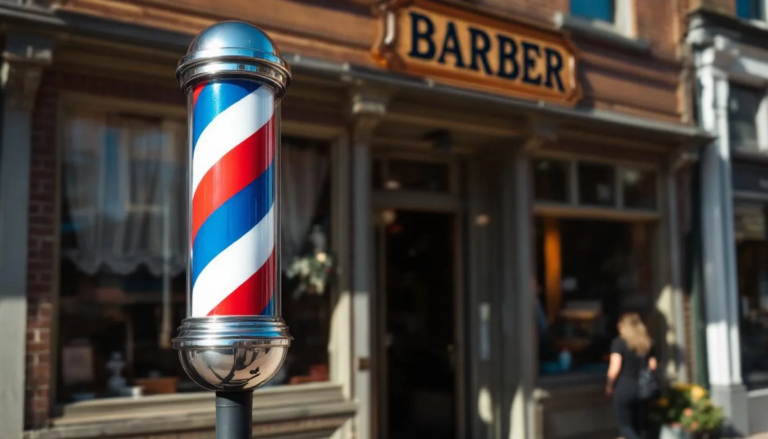
Key Takeaways
- The barber pole originated in medieval times when barbers performed bloodletting and surgical procedures alongside haircuts and shaves
- Red and white stripes symbolize blood-stained and clean bandages from bloodletting practices, while blue represents veins or venous blood
- The red and white stripes of the barber pole represent bloody bandages that were hung out to dry after procedures
- The spiral pattern comes from bloody bandages that were hung outside and twisted in the wind, later replaced by painted wooden poles
- By the 1540s, English law separated barbers from surgeons, with barbers using blue and white poles and surgeons using red and white poles
- Today’s barber pole remains an iconic symbol of the barbering profession, though modern barbers focus solely on grooming and hair services
Walking down any main street, the sight of a spinning barber pole immediately signals where to find professional grooming services. This iconic symbol, with its distinctive red and white stripes spiraling endlessly upward, represents one of the oldest and most recognizable trade signs in the world. Yet behind its familiar appearance lies a fascinating and somewhat gruesome history that connects modern barbershops to medieval medical practices.
The story of the barber pole is far more complex than most people realize. What began as a practical advertisement for bloodletting services eventually evolved into the cheerful symbol of haircuts and shaves we know today. This transformation reflects centuries of professional evolution, legal changes, and cultural shifts that separated medical practice from grooming services.
Origins and Ancient History
The barbering profession boasts ancient roots that stretch back to humanity’s earliest civilizations. Archaeological evidence suggests that Bronze Age societies developed the first razor tools, marking the beginning of organized grooming practices. These early implements, though crude by today’s standards, established barbering as one of mankind’s oldest trades.
The formal introduction of barbering to European culture occurred in Rome around 296 B.C., when the practice was brought from Sicily. Roman barbershops quickly became much more than places for grooming – they evolved into vital social hubs where men gathered to discuss politics, business, and current events. These establishments, known as “tonstrina,” served as the backbone of male social interaction in Roman society.
The very word “barber” derives from the Latin “barba,” meaning beard. This etymology reflects the central role that facial hair management played in ancient societies. In Roman culture, the distinction between free men and slaves was often marked by grooming practices: free citizens maintained clean-shaven faces as a symbol of their status, while slaves were required to wear beards as a mark of their servitude. The red color in the barber pole symbolizes arterial blood, while the blue color represents venous blood and white depicts the bandage.
This cultural significance of grooming established barbering as more than a simple service trade. From its earliest days, the profession carried social weight and cultural meaning that would persist through centuries of evolution. The barber shop became a place where social hierarchies were both maintained and challenged, setting the stage for the complex professional development that would follow.
The Medieval Barber-Surgeon Era
During the Middle Ages, the role of barbers expanded dramatically beyond simple grooming services. Medieval barbers, called barber surgeons, performed a remarkable range of medical procedures that would be unthinkable in modern barbershops. These practitioners handled everything from routine haircuts to complex surgical treatments, making them essential healthcare providers for common people who couldn’t afford academic physicians. During this period, barbers also worked as surgeons and dentists.
The scope of services provided by barber surgeons was truly comprehensive. They routinely performed bloodletting procedures, which were believed to cure ailments ranging from common colds to serious diseases. These skilled practitioners could set bones, extract teeth, treat wounds, and even perform minor surgeries. The patient gripped a pole during bloodletting procedures to encourage blood flow, creating one of the key symbols that would later define the trade.
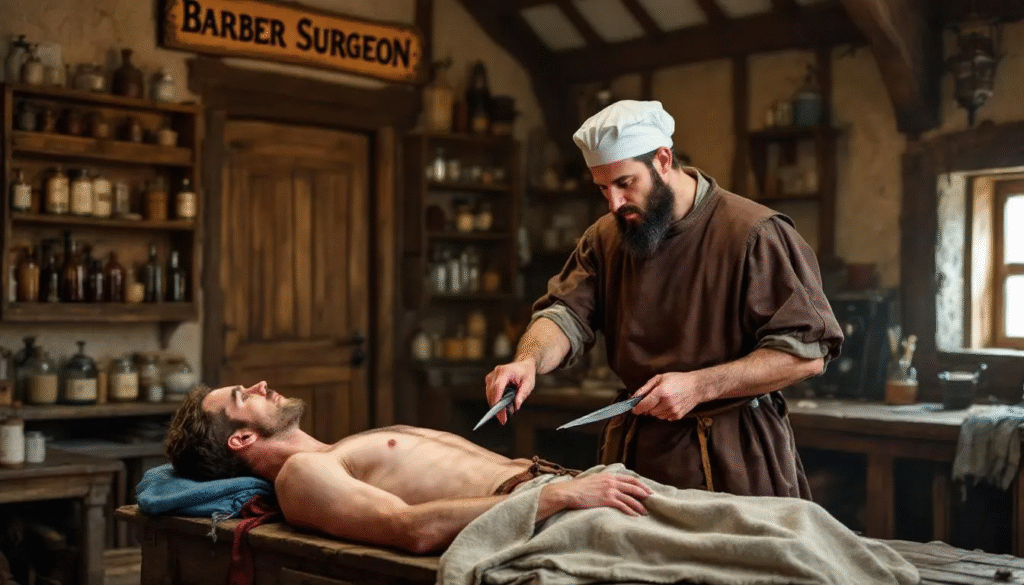
Professional organization began early in the medieval period. The first formal barber surgeon organization was established in France in 1094, creating standards and regulations for the expanding profession. This early guild system would become the foundation for professional barbering across Europe.
In Paris, the College de Saint-Come was founded in 1210, creating an important distinction between two types of medical practitioners. Academic surgeons, who wore long robes and held university degrees, were considered the elite of the medical profession. Barber surgeons, identifiable by their short robes, provided practical medical services to the general population. This division established a professional hierarchy that would influence the development of both barbering and surgery for centuries.
English barbers received their first royal charter in 1462, when they were formally recognized as the Company of Barbers. This official recognition legitimized their dual role in society and established legal protections for their practice. The guild system provided training, quality control, and professional standards that elevated barbering from a simple trade to a respected profession.
The culmination of this medieval evolution came in 1540 when King Henry VIII issued a statute creating the United Barber Surgeon’s Company. This organization formally united barbers and surgeons under one professional umbrella, while simultaneously beginning the process that would eventually separate the two professions entirely. Barbers and surgeons remained part of the same trade guild until the mid-1740s.
Bloodletting and Medical Practices
Bloodletting represented the cornerstone of medieval medical practice, and barber surgeons were its primary practitioners. This procedure was based on the ancient theory of humoral medicine, which held that illness resulted from an imbalance of bodily fluids. By removing “bad blood,” practitioners believed they could restore health and treat a wide variety of conditions.
The tools and procedures used during bloodletting sessions were surprisingly sophisticated for their time. Barber surgeons employed specialized knives, lancets, and cupping devices to carefully control the amount of blood removed. Leeches were also commonly used for more precise bloodletting, particularly in sensitive areas where surgical cutting might prove dangerous.
The pole that patients gripped during these procedures served multiple practical purposes. Gripping the staff helped distend veins, making them more visible and accessible for the barber surgeon. The physical tension also helped patients cope with the discomfort of the procedure. A brass basin was often attached to the top of the pole, serving as a vessel for collecting leeches or catching blood during the treatment.
These bloodletting sessions could address an remarkable range of complaints. Medieval people sought treatment for everything from headaches and fever to more serious conditions like pneumonia and plague. While modern medicine has thoroughly debunked the therapeutic value of bloodletting for most conditions, the practice was performed with genuine belief in its healing powers.
The frequency and popularity of bloodletting made it a cornerstone of the barber surgeon’s business. Unlike the academic surgeons who served wealthy clients, barber surgeons provided affordable medical care to common people. This accessibility made them indispensable members of their communities and established the foundation for their enduring professional identity. Barbers were often the only medical practitioners available to patients who could not afford physicians.
The Symbolism Behind Red, White, and Blue Colors
The distinctive color scheme of the barber pole carries deep symbolic meaning rooted in medieval medical practice. Each color represents a specific element of the bloodletting procedure, creating a visual advertisement that medieval people could easily understand and recognize.
Red stripes on the pole represent arterial blood and the blood-stained bandages used during procedures. This bold color served as an immediate indicator that medical services were available, signaling to potential patients that a trained practitioner worked within. The red also symbolized the life force that medieval medicine sought to balance through bloodletting.
White stripes symbolize the clean bandages and hygiene practices that distinguished professional barber surgeons from untrained practitioners. The contrast between red and white communicated both the medical nature of the services and the cleanliness standards maintained by the establishment. White also represented the pole itself – the staff that patients gripped during procedures.
The blue found on many modern barber poles, particularly in the United States, has multiple interpretations. Some sources suggest blue represents venous blood, creating a complete picture of the circulatory system alongside the red arterial blood. Others attribute the blue to patriotic symbolism, with the red, white, and blue reflecting the American flag and demonstrating national pride. The colors of red, white, and blue on barber poles in the U.S. are linked to the national flag and symbolize arterial blood, venous blood, and bandages respectively.
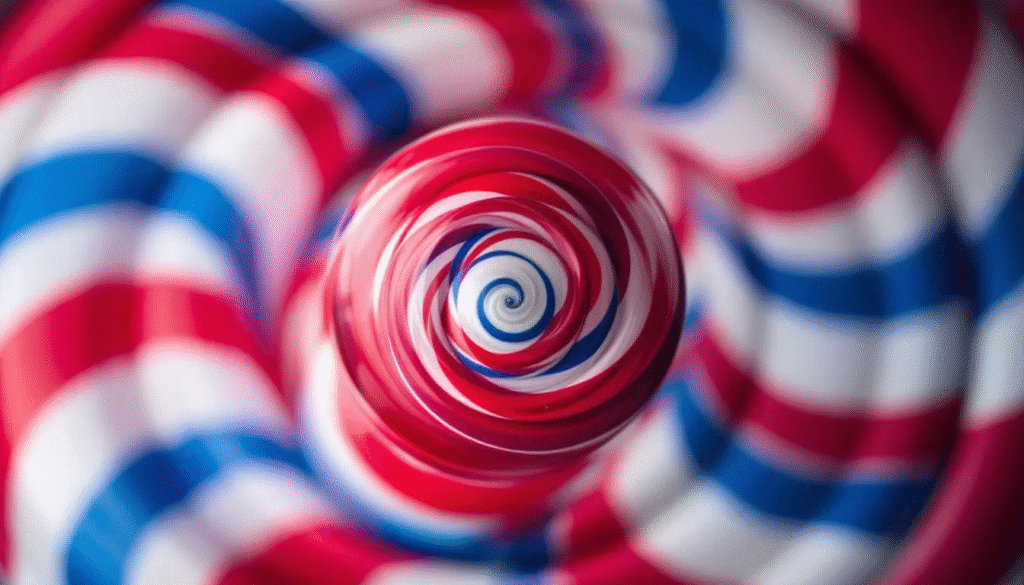
The familiar spiral pattern that defines the barber pole has equally practical origins. After bloodletting procedures, used bandages were hung outside shops to dry. As these bloody bandages twisted in the wind, they created a natural spiral pattern that became associated with barber surgeon services. This organic advertising method was eventually replaced by painted wooden poles featuring the same spiral design, providing a cleaner and more permanent advertisement.
The evolution from actual bloody bandages to painted representations marks a significant transition in the profession’s public image. As medical understanding advanced and hygiene standards improved, the literal display of medical waste became unacceptable. The painted pole preserved the symbolic meaning while presenting a more appealing storefront appearance.
Separation of Barbers and Surgeons
The gradual separation of barbering and surgery represents one of the most significant professional transformations in medieval and early modern Europe. This process, driven by advancing medical knowledge and changing social expectations, fundamentally altered both professions and established the modern boundaries we recognize today.
The first major step toward separation occurred in England with the 1540 statute that created the United Barber Surgeon’s Company. While this legislation initially united the professions, it also placed important restrictions on practice scope. Barbers were limited to haircuts, shaves, bloodletting, and tooth extractions, while more complex surgical procedures were reserved for trained surgeons.
This legal framework prevented barbers from performing the advanced surgical treatments that had previously been part of their practice. The statute specifically barred surgeons from providing basic grooming services like shaving and hair cutting, creating distinct professional territories for the first time. These restrictions reflected growing recognition that medical and grooming services required different types of training and expertise.
France followed a similar path under Louis XV, who banned barbers from performing surgery entirely in 1743. This royal decree represented a more complete separation than had occurred in England, reflecting the French monarchy’s desire to elevate surgical practice and distinguish it from common trade activities. The ban forced barbers to focus exclusively on grooming services while leaving surgical practice to university-trained physicians.
The establishment of the Royal College of Surgeons in London in 1800 marked the final institutional separation of the professions. This organization provided formal medical education and professional standards that were far beyond the scope of traditional barbering guilds. Surgery had evolved into a sophisticated medical specialty that required extensive anatomical knowledge and surgical training.
Professional symbols evolved alongside these legal changes. Barbers began using blue and white poles to distinguish their establishments from surgical practices, which continued to display red and white poles. This color differentiation helped consumers identify the appropriate provider for their needs while maintaining the symbolic connection to the shared professional heritage.
The separation process varied significantly across different regions and kingdoms. Some areas maintained combined practices well into the 19th century, while others enforced strict professional boundaries much earlier. These variations reflected local political structures, guild systems, and medical traditions that shaped professional development differently across Europe.
Modern Barber Pole Significance
Today’s barber pole has completed its transformation from medical symbol to purely commercial identifier, yet it retains powerful connections to centuries of professional tradition. Modern spinning barber poles often feature the red, white, and blue color scheme, particularly in the United States, where the patriotic symbolism has become deeply embedded in barbershop culture.
The mechanical spinning mechanism that characterizes many contemporary poles serves both practical and aesthetic purposes. The continuous motion attracts attention from passersby while creating the classic spiral illusion that has captivated observers for generations. This kinetic element distinguishes the barber pole from static signage and maintains its effectiveness as a marketing tool in busy commercial districts.
Global recognition of the barber pole extends far beyond its European origins. The symbol has become universally understood across Australia, Europe, and the Americas as an indicator of professional barbering services. Barber poles are recognized as symbols of professional licensed barbers everywhere. This international recognition demonstrates the enduring power of traditional trade symbols in an increasingly digital marketplace.
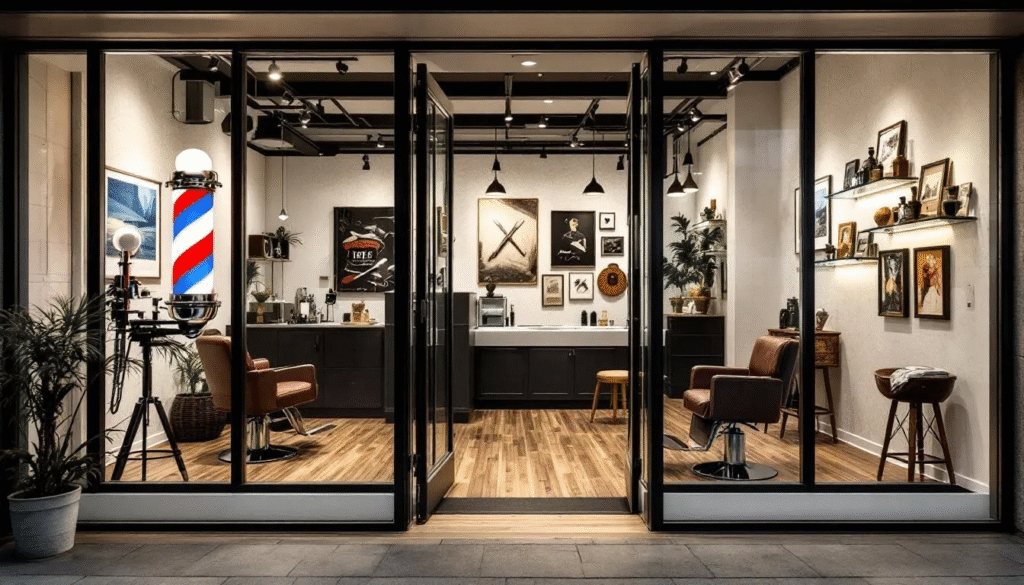
Contemporary barbers have embraced the pole’s heritage value while adapting it to modern business needs. Many establishments use the symbol to communicate authenticity, craftsmanship, and connection to traditional grooming techniques. The pole serves as a bridge between historical barbering practices and current service offerings, helping to differentiate professional barbers from generic hair salons.
The preservation of this tradition reflects the barbering profession’s commitment to maintaining its unique identity and cultural significance. While modern barbers focus exclusively on hair cutting, beard trimming, and traditional shaving services, they continue to honor the symbol that represents centuries of professional evolution and community service.
Professional licensing bodies in various jurisdictions have incorporated the barber pole into their regulatory frameworks. Some states require licensed barbershops to display appropriate signage, while others use the pole as an official symbol in licensing materials and professional documentation. These regulatory connections help maintain the symbol’s authenticity and protect its association with properly trained professionals.
The enduring appeal of the barber pole in an era of digital marketing and modern advertising techniques speaks to its fundamental effectiveness as a communication tool. The symbol transcends language barriers, cultural differences, and generational changes to convey a simple, powerful message about the services available within.
FAQ
Why do some barber poles spin while others don’t?
The spinning mechanism is typically motorized and serves to attract attention while creating the classic spiral illusion effect. Static poles are often chosen for aesthetic reasons, cost considerations, or local preferences. Both styles are equally valid representations of the barbering profession, with spinning poles being more common in high-traffic commercial areas where visibility is important.
Are there legal requirements for displaying barber poles?
Legal requirements vary significantly by jurisdiction. Some states and countries have regulations requiring licensed barbershops to display appropriate signage, which may include barber poles. However, many jurisdictions simply require clear identification as a licensed barbering establishment without mandating the specific use of traditional poles. It’s important to check local licensing requirements and zoning regulations.
What’s the difference between American and European barber pole designs?
American barber poles commonly feature red, white, and blue stripes, often attributed to patriotic symbolism reflecting the U.S. flag. European poles more frequently display the traditional red and white color scheme, maintaining closer connections to the historical bloodletting symbolism. The basic spiral pattern and cylindrical shape remain consistent across regions.
When did barbers stop performing medical procedures entirely?
The timeline varied by country and region. In England, the 1540 statute began restricting barber surgeons to limited procedures, while France banned barbers from surgery in 1743. The complete separation was largely achieved by the early 1800s in most developed countries, coinciding with the establishment of formal medical schools and surgical colleges. Some rural areas maintained combined practices longer due to limited access to trained physicians.
Do modern barbershops have to display a barber pole?
No, displaying a barber pole is traditional but not mandatory in most jurisdictions. Many contemporary barbershops choose alternative signage that reflects modern branding preferences while still maintaining professional licensing requirements. However, the pole remains popular because of its instant recognition value and connection to barbering heritage, making it an effective marketing tool for establishments that want to emphasize traditional services and craftsmanship.
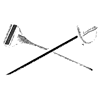
You might like these!



